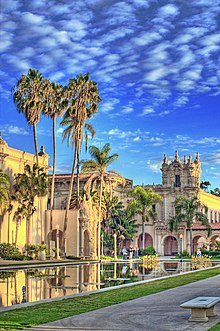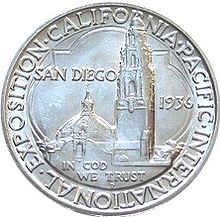California Pacific International Exposition
This article includes a list of references, related reading, or external links, but its sources remain unclear because it lacks inline citations. (July 2011) |

The California Pacific International Exposition was an exposition held in San Diego, California during May 29, 1935–November 11, 1935 and February 12, 1936–September 9, 1936. The exposition was held in Balboa Park, the site of the earlier 1915 Panama-California Exposition and San Diego's large urban central park.
Exposition
The Exposition was held was to promote San Diego and support its economy which had slowed down with the country's Great Depression. The exposition was a financial and attendance success due to creative designing, careful planning, enhanced employee training, and considerations for entertainments, restaurants, theaters, shopping, transportation, visitor security, and other details for a well functioning international event.
The exposition had hundreds of exhibits in history, the arts, horticulture, ethnic cultures, science, and industry. Some concessions and exhibits were unusual, such as the Gold Gulch, Lost Continent of Mu, Zoro Garden Nudist Colony, and the "1 ton (900 kg.) Mechanical Man."
Architecture
The buildings from the 1915 fair were Spanish Colonial Revival Style architecture, designed by Bertram Goodhue and Carleton Winslow. Architect Richard Requa designed the few new permanent buildings to be added for the 1935 Fair in a less sophisticated but 'charming' Vernacular Style, some with interesting Art Deco and Pueblo Revival Style architecture motifs and detailing. Some buildings and shaded arcades had new murals created. The 1935 Fair buildings that still remain are at Presidents Way, southwest of the original buildings at El Prado.
Exotic Landscaping and new gardens with lush exotic plants were built and planted in the courtyards and around the buildings, whilenative plants were used by landscape designer Kate Sessions beyond them, adding to her renowned design work for the Panama-California Exposition.
Commemorative coinage


In honor of the California Pacific International Exposition, the federal government released a commemorative silver half dollar; today referred to as the San Diego Half. The coin was authorized by congress and released with a stamp. Produced largely to sell to collectors for profit, 480,000 in total were minted, but all but 70,132 in 1935 in San Francisco and in 1936 30,092 in Denver were ultimately melted because they were unsold. The obverse depicts liberty seated with a spear in her right hand a shield with the state motto “eureka” above the head of medusa (California's former state seal). Also there is a bear to liberty's right and in the background there is a ship and a miner; all symbols of California. The reverse depicts the what is now the dome and tower of the Museum of Man in Balboa Park and reads “California Pacific International Exposition” and “San Diego” as well as the mint and year of mintage. These coins were not widely circulated, but some slightly worn examples imply some circulation.
Statistics
The Exposition took ten months to build. It attracted 7,220,000 visitors during its 377 days of operation. Visitors brought US$ 37,700,000 to San Diego. It employed 2700 people, half of them Federal relief workers. The cost was US$ 20,000,000. Admission was 50 cents for adults and 25 cents for children 2-11.
Four restaurants provided meals: Cafe of the World, Palisades Cafe, Spanish Kitchens, and the Pioneer Days Restaurant.
Twenty-one nations participated: Argentina, British Empire, Chile, China, Czechoslovakia, Denmark, Germany, Honduras, Irish Free State, Italy, Japan, Nicaragua, Norway, Panama, Paraguay, Portugal, Sweden, Uruguay, United States, Yugoslavia, and one unknown.
Legacy
Park improvements amounted to US$ 6,000,000. The exposition was so popular that some buildings were rebuilt to be made more permanent. Many buildings or reconstructed versions remain in use today, and are used by several museums and theatres in Balboa Park.
In the early 1960s destruction of a few of the buildings and their replacement by aesthetically clashing modern architecture style of the new buildings "created an uproar" in San Diego's community. A 'Committee of One Hundred' was formed by citizens to protect the park buildings. The Committee convinced the City Council to enact resolutions that now require any new buildings to be designed and constructed in the Spanish Colonial Revival Style. The Committee also worked with various government agencies for the remaining original buildings to be declared a National Historic Landmark, which was awarded in 1978. In the latter 1990s the buildings most deteriorated or that had burned were carefully rebuilt to restore the original scale of the park's public spaces.
See also
- "California Pacific International Exposition Official Guide: Souvenir Program and Picture Book" - 84 pages; 1935.
- "San Diego’s Balboa Park" - by David Marshall, AIA, Arcadia Publishing, 2007, ISBN 978-0-7385-4754-1.
- Spanish Colonial Revival architecture
External links
- "Do You Want an Exposition? San Diego's 1935 Fair in Photographs", 'The Journal of San Diego History 31:4 (Fall 1985) by Larry and Jane Booth
- California Pacific Exposition San Diego 1935-1936 History by Richard Amero (San Diego Historical Society)
- "The Crosby Exhibit of 1935 California Pacific International Exposition Covers" - Philatelic Exhibit (November 1999) by Lawrence Gregg
